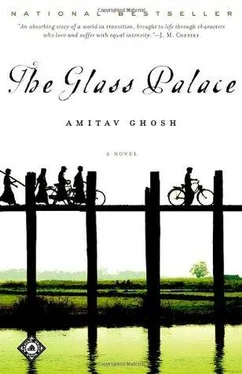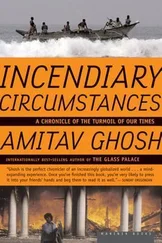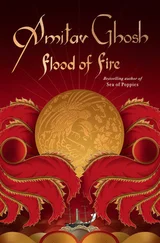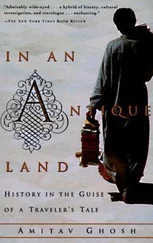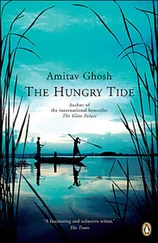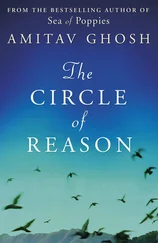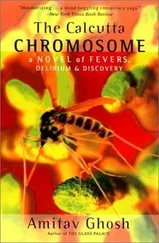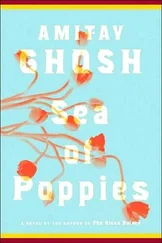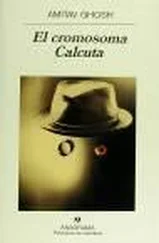‘Never.’ Dolly’s voice was emphatic. ‘If I went to Burma now I would be a foreigner — they would call me a kalaa like they do Indians — a trespasser, an outsider from across the sea. I’d find that very hard, I think. I’d never be able to rid myself of the idea that I would have to leave again one day, just as I had to before. You would understand if you knew what it was like when we left.’
‘Was it very terrible?’
‘I don’t remember much, which is a kind of mercy, I suppose.
I see it in patches sometimes. It’s like a scribble on a wall— no matter how many times you paint over it, a bit of it always comes through, but not enough to put together the whole.’
‘What do you see?’
‘Dust, torchlight, soldiers, crowds of people whose faces are invisible in the darkness. .’ Dolly shivered. ‘I try not to think about it too much.’
After this, in what seemed like an impossibly short time, Dolly and Uma became close friends. At least once a week, and sometimes twice and even more, Dolly would come over to the Residency and they would spend the day together. Usually they stayed in, talking and reading, but from time to time Dolly would have an idea for an expedition. Kanhoji would drive them down to the sea or into the countryside. When the Collector was away touring the district, Dolly would stay over to keep Uma company. The Residency had several guest rooms and Uma assigned one of these exclusively to Dolly. They would sit up talking late into the night. Often they would wake up curled on one another’s beds, having drifted off to sleep in mid-conversation.
One night, plucking up her courage, Uma remarked: ‘One hears some awful things about Queen Supayalat.’
‘What?’
‘That she had a lot of people killed. . in Mandalay.’ Dolly made no answer but Uma persisted. ‘Doesn’t it frighten you,’ she said, ‘to be living in the same house as someone like that?’
Dolly was quiet for a moment and Uma began to worry that she’d offended her. Then Dolly spoke up. ‘You know, Uma,’ she said in her softest voice. ‘Every time I come to your house, I notice that picture you have, hanging by your front door.’
‘Of Queen Victoria, you mean?’
‘Yes.’
Uma was puzzled. ‘What about it?’
‘Don’t you sometimes wonder how many people have been killed in Queen Victoria’s name? It must be millions, wouldn’t you say? I think I’d be frightened to live with one of those pictures.’
A few days later Uma took the picture down and sent it to the Cutchery, to be hung in the Collector’s office.

Uma was twenty-six and had already been married five years. Dolly was a few years older. Uma began to worry: what was Dolly’s future to be? Was she never to marry or have children? And what of the Princesses? The First Princess was twenty-three, the youngest eighteen. Were these girls to have nothing to look forward to but lifetimes of imprisonment?
‘Why doesn’t someone do something,’ Uma said to the Collector, ‘about arranging marriages for the girls?’
‘It’s not that no one’s tried,’ the Collector replied. ‘It’s the Queen who won’t allow it.’
In his offices at the Cutchery, the Collector had found a thick file of correspondence chronicling his predecessors’ attempts to deal with the question of the Princesses’ futures. The girls were in the prime of their womanhood. If there were to be a scandal or an accident at Outram House the incumbent Collector would be held responsible: the Bombay secretariat had left no room for doubt on this score. In order to protect themselves, several previous Collectors had tried to find suitable grooms for the Princesses. One had even written to his colleagues in Rangoon, to make enquiries about eligible Burmese bachelors — only to learn that there were only sixteen such men in the whole country.
The custom of the ruling dynasties of Burma was to marry very closely within their houses. Only a man descended of Konbaung blood in both lines was eligible to marry into the Royal Family. It was the Queen who was to blame for the fact that there were now very few such pure-blooded princes left: it was she who had decimated her dynasty by massacring all of Thebaw’s potential rivals. As for the few eligible men that there were, none found favour with the Queen. She announced that not a single one of them was a fit match for a true-born Konbaung Princess. She would not allow her daughters to defile their blood by marrying beneath themselves.
‘But what about Dolly?’ Uma said to the Collector. ‘Dolly doesn’t have to worry about finding a prince.’
‘That’s true,’ said the Collector, ‘but hers is an even stranger circumstance. She’s spent her whole life in the company of the four Princesses. But she’s also a dependant, a servant, of unknown family and origin. How would you set about finding a husband for her? Where would you start: here or in Burma?’
Uma had no answer for this. Neither she nor Dolly had ever broached the subject of marriage or children. With some of her other friends, Uma could talk of little else but of husbands, marriage, children — and of course, of remedies for her own childlessness. But with Dolly it was different: theirs was not the kind of friendship that was based on intimate disclosure and domesticity — quite the opposite. Both she and Dolly knew instinctively what could not be spoken of — Uma’s efforts to conceive, Dolly’s spinsterhood — and it was this that lent their meetings such an urgent wakefulness. When she was with Dolly, Uma felt as though a great burden had dropped from her mind, that she could look outside herself, instead of worrying about her own failings as a wife. Driving in the countryside for instance, she would marvel at the way in which people came running out of their houses to talk to Dolly, to hand her little odds and ends, fruits, a few vegetables, lengths of cloth. They would talk for a while, in Konkani, and when they were on their way again, Dolly would smile and say, in explanation, ‘That woman’s uncle [or brother or aunt] used to work at Outram House.’ Despite her shrugs of self-deprecation, Uma could tell that there was a depth to these connections that went far beyond the casual. Often Uma longed to know who exactly these people were and what they and Dolly were speaking of. But in these encounters it was she who was the outsider, the memsahib: to her, for once, fell the silence of exile.
Occasionally, when the crowds around them grew too large, Kanhoji would issue scoldings from his bench, telling the villagers to clear the way for the Collector’s gaari, threatening to call the police. The women and children would glance at Uma; on recognizing the Collector’s wife, their eyes would widen and they would shrink away.
‘You see,’ Dolly said once, laughing. ‘The people of your country are more at home with prisoners than gaolers.’
‘I’m not your gaoler.’
‘What are you then?’ Dolly said, smiling, but with a note of challenge audible in her voice.
‘A friend. Surely?’
‘That too, but by accident.’
Despite herself, Uma was glad of the note of scorn in Dolly’s voice. It was a tonic restorative to the envy and obsequiousness she met with everywhere else, as the wife of the Collector and the district’s pre-eminent memsahib.
One day, while driving out in the coach, Dolly had a sharp exchange of words with Kanhoji through the connecting window. They quickly became absorbed in their argument and Dolly seemed almost to forget Uma’s presence. At intervals she made attempts to resume her normal manner, pointing at landmarks, and offering anecdotes about villages. But each time her anger got the better of her so that within moments she was at it again, whipping round to hurl a few more words at the coachman.
Читать дальше
Конец ознакомительного отрывка
Купить книгу
